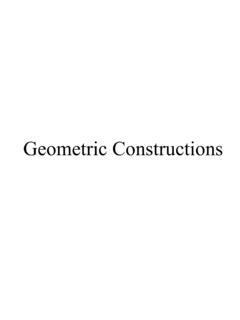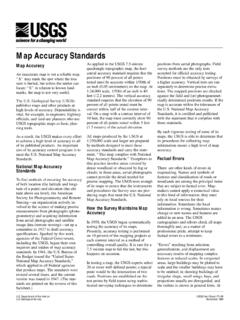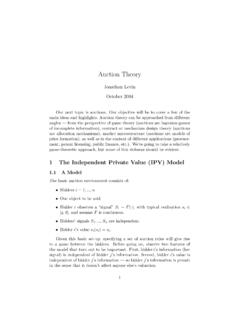Transcription of Equivalence Relations - Mathematical and Statistical Sciences
1 Equivalence Relations Definition An Equivalence relation on a set S, is a relation on S which is reflexive, symmetric and transitive. Examples: Let S = and define R = {(x,y) | x and y have the same parity}. , x and y are either both even or both odd. The parity relation is an Equivalence relation. 1. For any x , x has the same parity as itself, so (x,x) R. 2. If (x,y) R, x and y have the same parity, so (y,x) R. 3. If (x,y) R, and (y,z) R, then x and z have the same parity as y, so they have the same parity as each other (if y is odd, both x and z are odd; if y is even, both x and z are even), thus (x,z). R. Examples Let S = and define the "square" relation R = {(x,y) | x2 = y2}. The square relation is an Equivalence relation. 1. For all x , x2 = x2, so (x,x) R. 2. If (x,y) R, x2 = y2, so y2 = x2 and (y,x) R. 3. If (x,y) R and (y,z) R then x2 = y2 = z2, so (x,z) R.
2 For any set S, the identity relation on S, IS = {(x,x) | x S}. This is an Equivalence relation for rather trivial reasons. 1. obvious 2. If (x,y) R then y = x, so (y,x) = (x,x) R. 3. If (x,y) R and (y,z) R then x = y = z, so (x,z) = (x,x) R. Modular Arithmetic Let S = . For each positive integer m, we define the modular relation m ,by x m y iff m | (x-y), m = {(x,y) : m | x y }. Examples: 7 5 2, 11 5 1, 10 5 0, -12 5 3. 7 3 1, 11 3 2, 10 3 1, -12 3 0. Another way to think about the modular relation is: x m y iff x and y have the same remainder when divided by m. By the division algorithm, x = mq1 + r1, y = mq2 + r2, so x y = m(q1-q2) + (r1-r2) so, m | x-y iff m| r1- r2. Since | r1-r2 | < m, m|r1 r2 iff r1 -r2 = 0 iff r1 = r2. Modular Arithmetic Theorem: For any natural number m, the modular relation m is an Equivalence relation on.
3 Pf: For any x in , since x x = 0 and m | 0, x m x. (Reflexitivity). If x m y then m | x y. Since y x = -(x-y), m | y x, and so, y m x. (Symmetry). If x m y and y m z then m | x y and m | y z. Since x z = (x y) + (y z). we have m | x z, so x m z. (Transitivity). Equivalence Classes Given an Equivalence relation R on a set S, we define the Equivalence class containing an element x of S by: [x]R = {y | (x,y) R} = {y | x R y}. The text uses the notation x/R (which I am not fond of) for what I. have called [x]R. Examples: Let S = {1, 2, 3} and R = {(1,1), (2,2), (3,3), (1,2), (2,1)}. Then [1] = {1,2} [2] = {1,2} [3] = {3}. 2 2. Let S = and R = {(x,y) | x = y }. Then [0] = {0}, [1] = {1,-1}, [ ] = { , - }, [x] = {x, -x}. Equivalence Classes More Examples: Let S = and R = {(x,y) | x and y have the same parity}. [0] = [2] = .. = [2k] = {0, 2, 4, 6.}
4 , 2k, ..}. [-1] = [1] = .. = [2k+1] = { 1, 3, 5, .., 2k+1, ..}. For any set S, IS = {(x,x) | x S}. [a] = {a} for all a S. Let S = and R = " 5 ". [0] = {0, 5, 10, 15, .., 5k } (k ). [1] = {.., -9, -4, 1, 6, 11, .., 5k + 1 }. [2] = {.., -8, -3, 2,7,12, .., 5k+2 }. [3] = {.., -7, -2, 3, 8, 13, .., 5k+3 }. [4] = {.., -6, -1, 4, 9, 14, .., 5k+4 }. Properties of Equivalence Classes Let R be an Equivalence relation on the set S. I. For all x S, x [x]. Since R is reflexive, (x,x) R for all x S. II. If y [x] then x [y], and [x] = [y]. Since R is symmetric, if y [x] then (x,y) R so (y,x) R. and we have x [y]. If s [x], then (x,s) R, so (s,x) R and then (s,y) R (by transitivity) and finally (y,s) R, so s [y]. Similarly, if t [y] then t [x] and so, [x] = [y]. III. For any x and y S, either [x] = [y] or [x] [y] = . If there is a z [x] which is also in [y], then (x,z) R and (y,z).
5 R. By symmetry, (z,y) R as well. By transitivity, (x,y) R, so y [x]. By II, [x] = [y]. An Important Equivalence Relation Let S be the set of fractions: S=. p q {. : p , q , q 0 }. Define a relation R on S by: a c b R d iff ad =bc . This relation is an Equivalence relation. 1) For any fraction a/b, a/b R a/b since ab = ba. (Reflexitivity). 2) If a/b R c/d, then ad = bc, so cb = da and c/d R a/b. (Symmetry). 3) If a/b R c/d, and c/d R e/f, then ad = bc and cf = de. Multiply the first equation by f, to get adf = bcf , so adf = bde. Divide by d (which is not 0) to get af = be, so a/b R e/f. (Transitivity). An Important Equivalence Relation The Equivalence classes of this Equivalence relation, for example: [] {. 1. 1. =. 2 3 k , , , , . 2 3 k }. [] {. 1. 2. =. 2 3 4. , , , , 4 6 8. k 2k , }. [] {. 4. 5. =. 4 8 12 k , , , , 4 k , , 5 10 15 5 }.
6 Are called rational numbers. The set of all the Equivalence classes is denoted by . Partitions A partition of a set S is a family F of non-empty subsets of S such that (i) if A and B are in F then either A = B or A B = , and (ii) union A = S . A F. S. Partitions If S is a set with an Equivalence relation R, then it is easy to see that the Equivalence classes of R form a partition of the set S. More interesting is the fact that the converse of this statement is true. Theorem : Let F be any partition of the set S. Define a relation on S by x R y iff there is a set in F which contains both x and y. Then R is an Equivalence relation and the Equivalence classes of R. are the sets of F. Theorem Let F be any partition of the set S. Define a relation on S by x R y iff there is a set in F which contains both x and y. Then R is an Equivalence relation and the Equivalence classes of R are the sets of F.
7 Pf: Since F is a partition, for each x in S there is one (and only one). set of F which contains x. Thus, x R x for each x in S (R is reflexive). If there is a set containing x and y then x R y and y R x both hold. (R. is symmetric). If x R y and y R z, then there is a set of F containing x and y, and a set containing y and z. Since F is a partition, and these two sets both contain y, they must be the same set. Thus, x and z are both in this set and x R z (R is transitive). Thus, R is an Equivalence relation. Theorem Consider the Equivalence classes of this Equivalence relation. [x] = {y | x and y are in some set of F}. Let A be a set of the partition F. Since A is non-empty, it contains an element x. Now, y A iff y [x], so A = [x]. Order Relations Partial Orders Definition: A relation R on a set A is a partial order (or partial ordering) for A if R is reflexive, antisymmetric and transitive.
8 A set A with a partial order is called a partially ordered set, or poset. Examples: The natural ordering " "on the set of real numbers . For any set A, the subset relation defined on the power set P (A). Integer division on the set of natural numbers . Predecessors Definiton: Let R be a partial ordering on a set A and let a,b A. with a b. Then a is an immediate predecessor of b if a R b and there does not exist c A such that c a, c b, a R c and c R b. Examples: Consider the partial order " " on . 5 is an immediate predecessor of 6 since 5 6 and there is no integer c not equal to 5 or 6 which satisfies 5 c 6. 3 is not an immediate predecessor of 6 since 3 c 6 is satisfied by 4 or 5. Now consider the partial order given by integer division on . 3 is an immediate predecessor of 6 since there is no integer c which 3 divides and which divides 6 other than 3 or 6.
9 3 is also an immediate predecessor of 9, but not of 12. Hasse Diagrams Definition: A Hasse diagram for a partial order is a digraph representing this relation in which only the arcs to immediate predecessors are drawn and the digraph is drawn so that all arcs are directed upwards (we then remove the arrow heads). Example: Consider the poset {1,2, ..,12} with integer division as the partial order. The Hasse diagram for this poset is given by Hasse Diagrams Let S = {a,b,c,d} and consider P(S) with subset inclusion (a poset). The Hasse diagram would be: {a,b,c,d}. {a,b,c} {a,b,d} {a,c,d} {b,c,d}. {a,b} {a,c} {a,d} {b,c} {b,d} {c,d}. {a} {b} {c} {d}.. Supremum Definition: Let R be a partial order for A and let B be any subset of A. Then a A is an upper bound for B if for every b B, b R a. Also, a is called a least upper bound (or supremum) for B if 1) a is an upper bound for B, and 2) a R x for every upper bound x for B.
10 Example: Reals with the usual ordering. B = {x | 5 < x < 7 }. 8, , 11, are all upper bounds of B. 7 is also an upper bound, and 7 any of the upper bounds, so 7 is a least upper bound of B (Note that 7 is not in B). Infimum Similarly, a A is a lower bound for B if for every b B, a R b. Also, a is called a greatest lower bound (or infimum) for B if 1) a is a lower bound for B, and 2) x R a for every lower bound x for B. We write sup(B) [sometimes (B)] to denote the supremum of B. and inf(B) [sometimes (B)] to denote the infimum for B. Example In the example below (Hasse diagram), consider B = {2,3}. Both 6 and 12 are upper bounds of this subset and 6 is the sup(B). The only lower bound of B is 1 and inf(B) = 1. Now let B = {4,6}. Sup{B) = 12 and Inf(B) = 2. Consider the set C = {2,3,5}. There is no upper bound for C, and 1. is a lower bound and also inf(C).}












